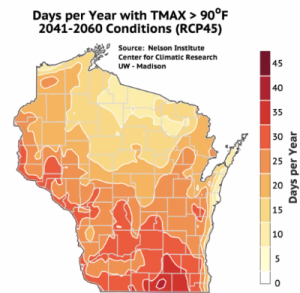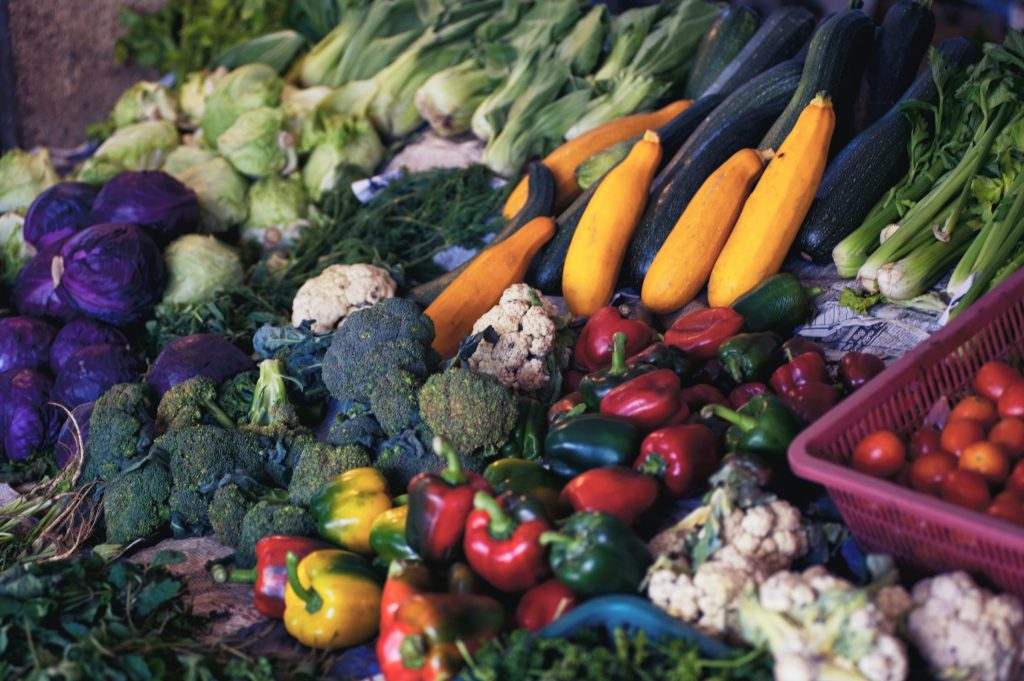Home » Community Climate Resilience Menu » Explore Our Menus » Built & Natural Environment Menu » Increased Droughts
Increased Droughts

The climate in Wisconsin, while projected to become wetter overall, is also conducive to droughts, particularly during the summer months. Wisconsin has experienced droughts that have lasted for a number of years and cycles of drought. Climate change will affect the magnitude and duration of drought.
Droughts occur as a result of increasing temperatures combined with prolonged periods of lower than average precipitation. The Wisconsin Initiative on Climate Change Impacts (WICCI) projects increases in the days above 90-degrees F by mid-century. Droughts may occur regionally or throughout the state and can last for weeks, months, or years. As a period of drought progresses, groundwater and lake levels drop, flow in streams and rivers is reduced, and wetlands may dry out. Because water is critical to Wisconsin’s environment, culture, and economy these decreases have cascading effects on ecosystems and people.
Who and What Will be Affected
Communities may face a number of issues as a result of drought events including limited water supplies, decreased air quality, increased insect-borne disease exposure, increased risk of wildfire, and decreases in streamflow and lake and groundwater levels. Strains on groundwater, surface water, and drinking water affect food production, businesses, and some community activities.
Increases in drought duration and frequency in Wisconsin communities may affect groups of people disproportionately and affect organisms, their ecosystems, and the biodiversity of ecosystems in different, and often detrimental ways. Additionally, droughts may adversely affect plant and animal communities that may be vulnerable to these conditions.
Water and food
Water security and changes in water quality are primary concerns during drought events. Depending on where community members source their water from, they may either have restrictions imposed during drought events or may unknowingly be ingesting groundwater contaminants. During periods with lower groundwater levels, shallow drinking water wells may become partially or completely dry and changes in flow may occur within the drinking water supply system. Water quality is also subject to change with more concentrated dissolved solids, microbes, and other contaminants.
During a drought, managing water use, encouraging water testing, and educating the public in water conservation strategies can help communities increase their resiliency. Additionally, local nutritious foods may not be readily available or may become more expensive as a result of crop failures caused by droughts.
Explore Related Menu
Decreased air quality
Dry conditions, high wind speeds, and wildfires may decrease air quality resulting in increased levels of dust, pollen, and other airborne particulates. Poor air quality may worsen respiratory conditions such as asthma, particularly in vulnerable young and senior populations. In areas where soils may be exposed and easily eroded by wind, such as large crop fields, planting cover and drought-tolerant vegetation can reduce particulates entering the air.
Insects and disease
Droughts may reduce the size of bodies of water and cause portions of them to stagnate as well as drive people to collect and improperly store rainwater. Both of these situations may provide conditions for mosquito larvae that can harbor diseases such as West Nile Virus. Pest insect populations can be reduced with proper storage of collected rainwater. In bodies of water where water stagnation occurs, aeration can be provided to support fish species that feed on mosquito larvae to help reduce mosquito populations.
Drought conditions can create problems for some native plant and animal species and ecosystems. As warmer weather enhances the presence of drought-tolerant invasive pests, fungal diseases, and competitive invasive plant species, native ecosystems may become increasingly more vulnerable. Some native species of trees, vegetation, and animals will be greatly affected during drought conditions while others may thrive. Learning about the vulnerability or resiliency of species and ecosystems in a community in your region will help to make management decisions for greater resilience.
Explore Our Menu
Equity & Environmental Justice
Equity & Environmental Justice – Equity and justice should be included with each part of the menu. As you explore each menu, consider the most vulnerable populations within your community. Be sure to include and prioritize these groups as you develop and plan your efforts.
View Equity & Environmental Justice
- Consider community members with chronic health conditions, such as asthma. Drought conditions such as heat, and poor air quality may disproportionately affect them. Communities can review and monitor air quality during drought events:
- Identify community members at greatest risk for health concerns during droughts:
- Educate community members procuring drinking water from private wells about higher risks from well water during droughts due to increased concentrations of pathogens and contaminants:
- Learn about tribal perspectives and approaches related to climate change:
- Learn more about vectorborne disease:
- A diverse group of collaborators representing tribal, academic, intertribal and government entities in Minnesota, Wisconsin and Michigan, developed a framework to integrate indigenous and traditional knowledge, culture, language and history into the climate adaptation planning process.
Education & Information
Education & Information – provides education and information ideas and resources. These are intended to be some of the first steps a community can take to address certain subsections.
View Education & Information
- Examine the current and projected changes in precipitation in Wisconsin:
- Explore Wisconsin’s Drought Toolkit a planning guide for public health and emergency response professionals:
- Explore hazards, assess vulnerability and risk, investigate options, prioritize and plan, take action:
- Examine groundwater and soil moisture conditions through maps created by NASA. These maps show current groundwater percentage maps of the U.S. and are used as drought indicators:
- Access a range of information and services related to drought including early warnings, climate data, and decision support services:
- Learn about impacts to lakes and rivers:
- Learn about urban wildlife, threats to urban wildlife, and ways humans and wildlife can live together:
- Find out about best practices related to creating habitat for monarchs:
- Identify vulnerable natural communities and drought-tolerant species:
- Climate Change Vulnerability Assessments (CCVAs) for Plants and Natural Communities
- Climate Change Projections for Tree Species in the Northwoods (MN, WI, MI)
- Climate change field guide for northern Wisconsin forests, 2nd Edition
- US EPA What to Plant
- Climate Wisconsin 2050: Forestry
- WICCI Plants & Natural Communities Working Group
- Learn about invasive species:
Low-Cost Strategies
Low-Cost Strategies – are focused on strategies and accompanying resources that usually will not require intensive staff capacity, fiscal resources, and maybe done through staff decisions.
View Low-Cost Strategies
- Monitor drought/precipitation trends and current conditions and prepare accordingly:
- Conserve and steward urban and suburban habitat patches including landscape yards with native plants and reduce the use of fertilizer to Conserve and steward urban and suburban habitat patches:
- Landscape yards and create demonstration sites on public land with drought tolerant native plants:
Significant Resource Deployment
Significant Resource Deployment – are strategies that may require more staff capacity, increased fiscal resources, and larger, possibly cohesive decisions.
View Significant Resource Deployment
- Consult farmers on crop rotation and transitioning to less water demanding crops to protect food supply during drought events:
- Plant vegetative cover to protect against wind erosion:
- Incorporate drought-tolerant tree species into community landscaping:
- Jumpstart water conservation efforts with water utilities:
- Create a policy or incentives to conserve/recycle water resources:
- Enact ordinances on water use (restrictions) during drought events.
Celebrating Successes
Celebrating Successes – are actions and strategies for communities to celebrate and keep the momentum going. They will help address positive outcomes of previous strategies taken and inspire further action.
View Celebrating Successes
- Conduct demonstrations, tours, and presentations showcasing some of the successful projects that highlight climate mitigation and adaptation practices, such as natural landscaping (prairie, for example) in public parks or other areas.
Grants & Funding
Grants & Funding – help communities support actions through financial means such as grants and other resources.
View Grants & Funding
- Listing of numerous short-term and long-term drought relief and recovery funding programs:






